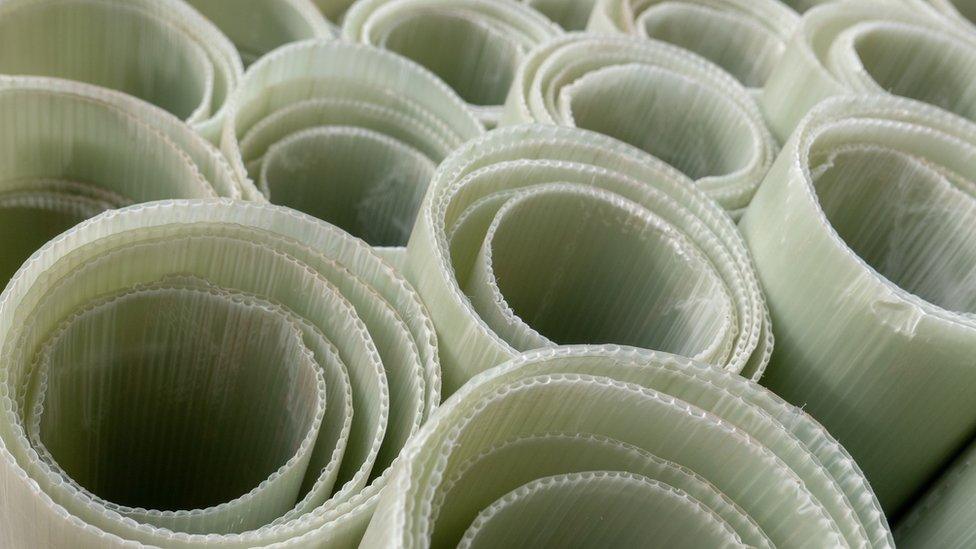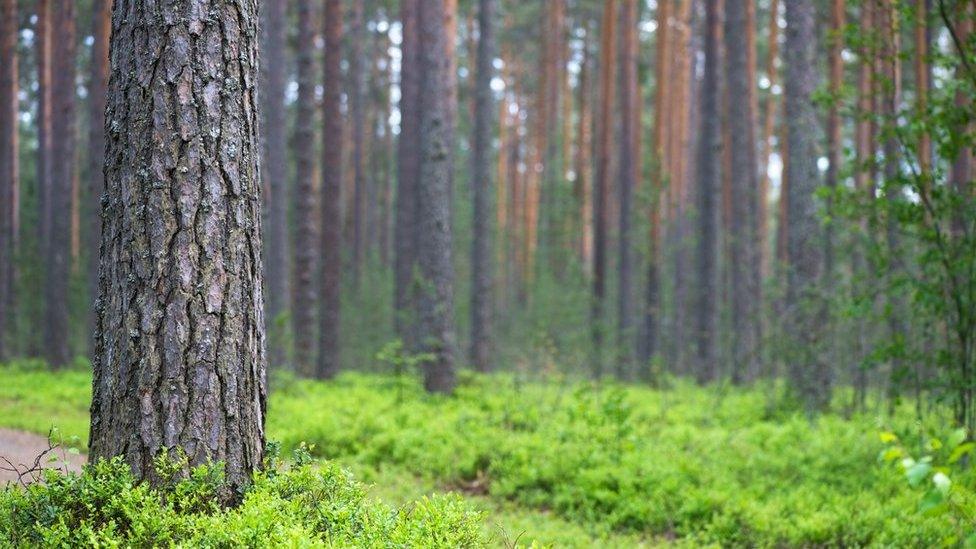The drive to stop plastic pollution growing in new forests
- Published
- comments

An area of new planting in the Highlands using plastic protection
Scotland's forestry industry says it is taking action to reduce the plastic pollution caused by tree planting.
Hundreds of thousands of plastic tube tree guards are used every year to protect saplings from being eaten by deer, rabbits and voles.
Most are made from single-use plastics and are often left to disintegrate in the open when a tree grows.
Forestry and Land Scotland said it would now use recyclable tubes or those containing half as much plastic.
Planting trees is widely seen as environmentally beneficial, so it is ironic that it can also be a source of vast quantities of plastic waste.
Findhorn-based charity Trees for Life has planted more than 1.6 million trees in the Highlands as part of efforts to regenerate native forests.
It hardly ever uses plastic tree tubes. Instead, it uses fencing to keep hungry deer away from saplings.

Plastic guards are used to protect saplings from being eaten by deer, rabbits and voles
Trees for Life conservation manager Alan McDonnell said it was very easy to put tree guards out and then forget about them.
He said: "If people are carrying out very large planting projects and relying on tree tubes then they are bringing a lot of plastic into the landscape. For years all you see is these cylinders sticking up."
He said the tube would eventually burst or the tree would fail inside it.
He added: "The tube will stand there for years, then slowly fall down, break up and then gradually it will degrade.
"Those plastics will be left in the soil and just get absorbed into the environment. Then you get these localised pockets of plastic pollution, which are bad news."
The Scottish government has a target for 24,710 acres (10,000 hectares) of new forest to be planted each year, and plastic tree guards are often used by the public sector.
For example, about 16,000 trees and shrubs have been planted in tubes alongside the new dual carriageway stretch of the A9 between Kincraig to Dalraddy in the Cairngorms National Park.
However, efforts are being made to tackle the pollution created by single use plastic tree guards.

The Scottish government wants to create large areas of new forest
Public body Forestry and Land Scotland said it used tree guards to aid the establishment of young trees in certain circumstances - depending on tree species and local deer, rabbit, hare or vole populations.
A spokesman said: "Of the 25 million trees that we plant annually when restocking or when creating new woodlands, only 1.6% of them will require tree guards.
"However, as a responsible land manager we are always looking for environmentally friendly ways of working and have recently started using new products that use half as much plastic or which are recyclable.
"We would certainly be very interested in trialling any effective and wholly biodegradable product that would meet the need to protect young trees for the necessary amount of time. Ideally, if a viable alternative was to become available, we'd like to stop using tree guards altogether."
Responsible collection
He added: "However, until such time as a suitable product becomes available, we will continue to look at minimising the use of tree guards, maintaining them in situ, removing them when trees are established and then disposing of them appropriately."
Plastic tree guards, which were invented in Scotland, remain popular as they not only protect saplings from browsing animals but also encourage growth by creating a miniature greenhouse effect.
Manufacturer Berry Global is developing ways to reduce their environmental impact.
Marketing director James Taylor said the key to this was ensuring responsible collection and disposal.
He said: "We are working at the moment to see how we can collect used tree guards after their five to eight-year lifespan."
"We want to make sure it is as easy as possible for people to deposit them somewhere locally so we can collect them and reprocess them into new products to try to close the loop and get closer to that circular economy."